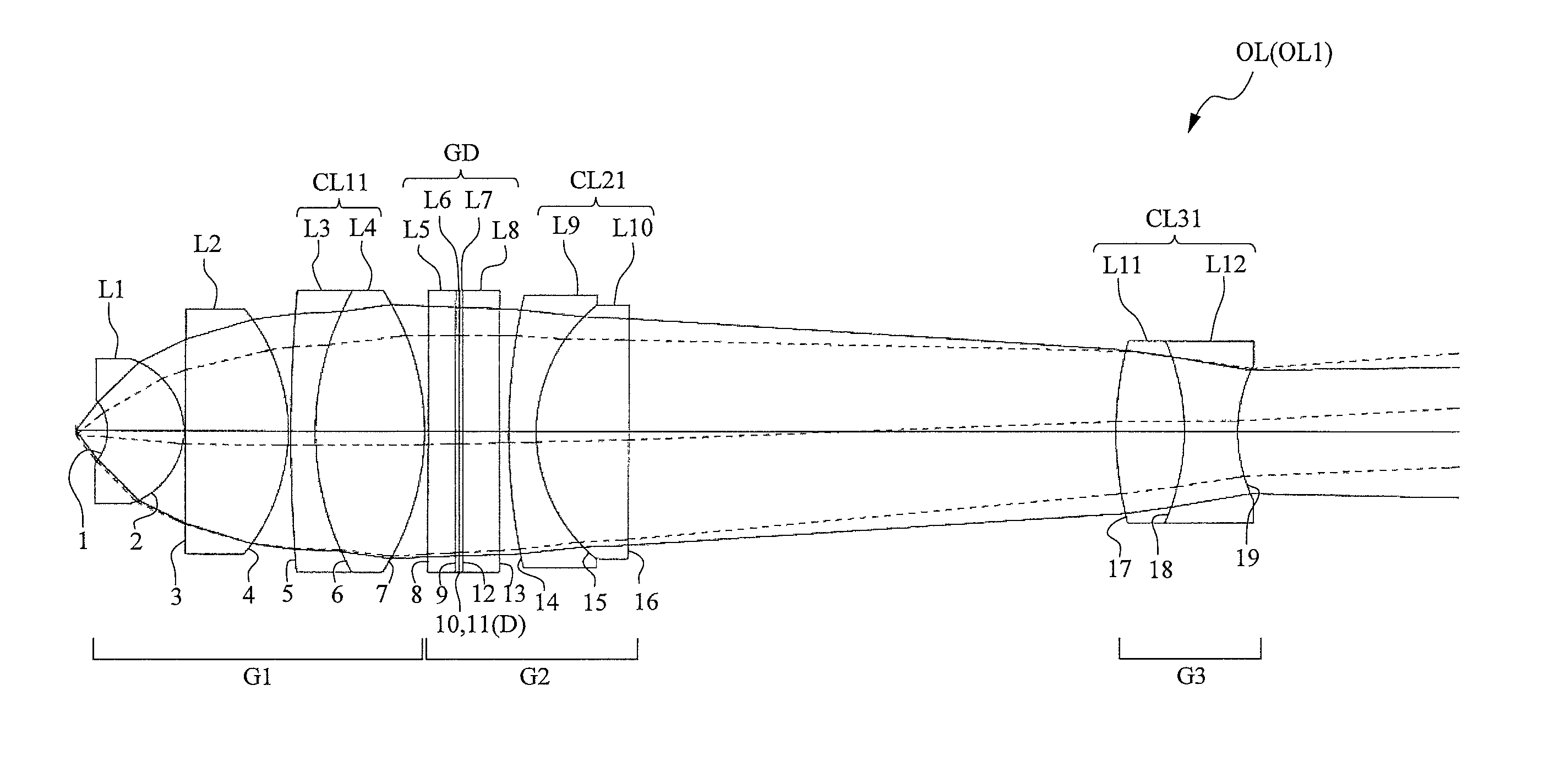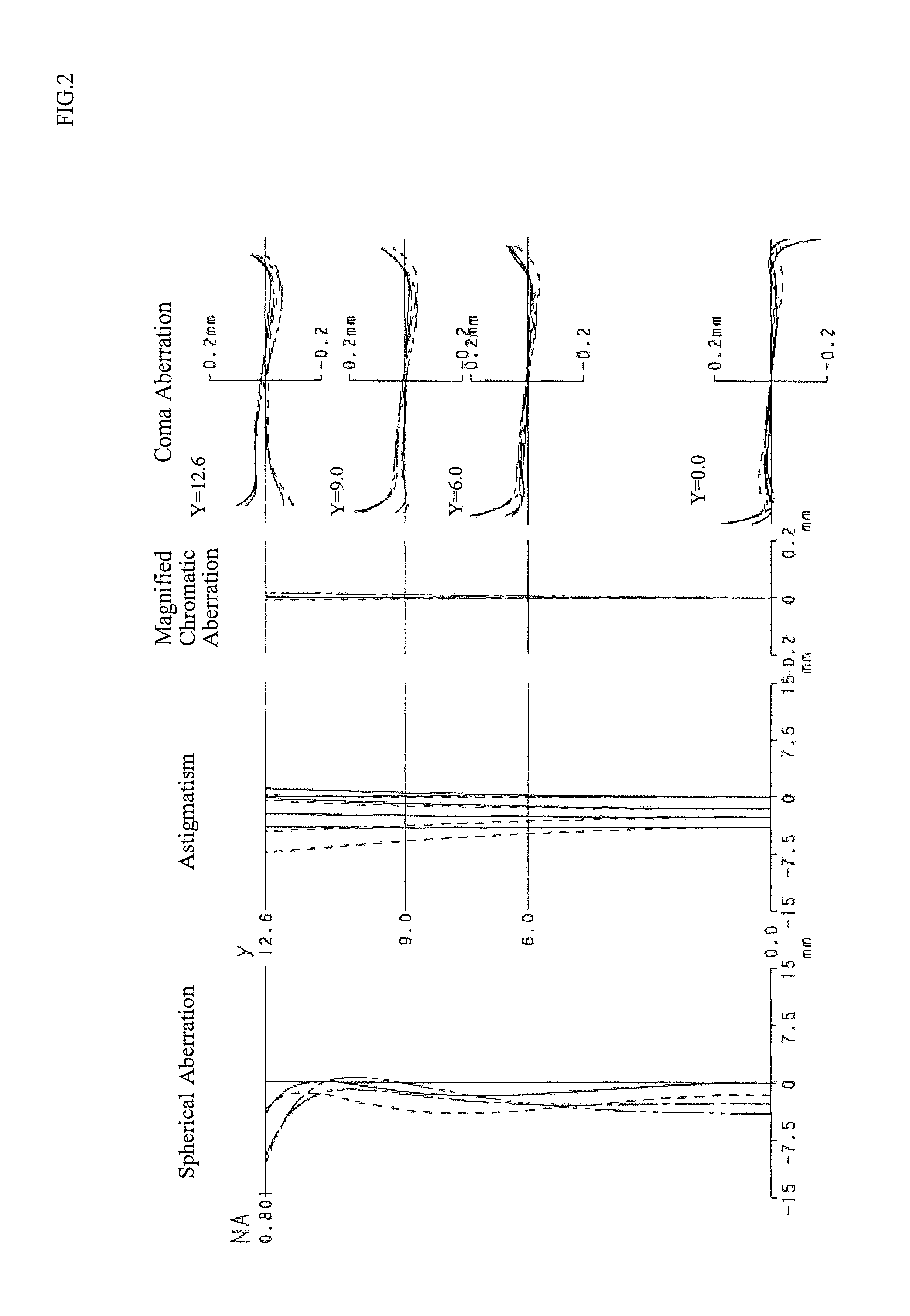Microscope objective lens including a diffractive optical element
a technology of diffractive optical elements and microscopes, applied in the field of microscope objective lenses, can solve the problems of inconvenient cost of conventional microscope objective lenses, and achieve the effects of sufficient visual field range, favorable correction, and sufficient correction of chromatic aberration
- Summary
- Abstract
- Description
- Claims
- Application Information
AI Technical Summary
Benefits of technology
Problems solved by technology
Method used
Image
Examples
first embodiment
[First Embodiment]
[0051]Hereinafter, preferred embodiments of the present invention will be described with reference to the drawings. First, a high-magnification microscope objective lens will be described. FIG. 1 illustrates a microscope objective lens OL according to a first embodiment comprising, in order from the object side, a first lens group G1 having a positive refractive power, a second lens group G2, and a third lens group G3 having a negative refractive power.
[0052]In the microscope objective lens OL described above, the first lens group G1 is a lens group for approximating a divergent light bundle from an object to a parallel light bundle. To this end, the first lens group G1 is configured so as to include a positive lens component (for example, a positive meniscus lens L1 illustrated in FIG. 1) having a lens surface with a negative refractive power, and at least one achromatizing lens component (a cemented lens CL11 illustrated in FIG. 1) that joins a positive lens and ...
second embodiment
[Second Embodiment]
[0072]Next, a case of a microscope objective lens having a long working distance will be described. FIG. 11 illustrates a microscope objective lens OL according to a second embodiment comprising, in order from the object side, a first lens group G1 having a positive refractive power, a second lens group G2 having a positive refractive power, and a third lens group G3 having a negative refractive power.
[0073]In the microscope objective lens OL described above, the first lens group G1 is a lens group for approximating a divergent light bundle from an object to a parallel light bundle. To this end, the first lens group G1 is configured so as to include a positive lens component (for example, a positive meniscus lens L1 illustrated in FIG. 11) having a lens surface with a negative refractive power, and at least one achromatizing lens component (a cemented lens CL11 illustrated in FIG. 11) that joins a positive lens and a negative lens. The positive lens component may ...
third embodiment
[Third Embodiment]
[0092]Finally, a low-magnification microscope objective lens will be described. FIG. 19 illustrates a microscope objective lens OL according to a third embodiment comprising, in order from the object side, a first lens group G1 having a positive refractive power, a second lens group G2, and a third lens group G3 having a negative refractive power.
[0093]In the microscope objective lens OL described above, the first lens group G1 is a lens group for approximating a divergent light bundle from an object to a parallel light bundle. To this end, the first lens group G1 is configured so as to include a positive lens component (for example, a positive meniscus lens L1 illustrated in FIG. 19) positioned nearest to the object side and having a lens surface with a negative refractive power. The positive lens component may be configured using a single lens or a cemented lens. If r denotes a curvature radius of the lens surface (for example, a first surface illustrated in FIG....
PUM
 Login to View More
Login to View More Abstract
Description
Claims
Application Information
 Login to View More
Login to View More - R&D
- Intellectual Property
- Life Sciences
- Materials
- Tech Scout
- Unparalleled Data Quality
- Higher Quality Content
- 60% Fewer Hallucinations
Browse by: Latest US Patents, China's latest patents, Technical Efficacy Thesaurus, Application Domain, Technology Topic, Popular Technical Reports.
© 2025 PatSnap. All rights reserved.Legal|Privacy policy|Modern Slavery Act Transparency Statement|Sitemap|About US| Contact US: help@patsnap.com



